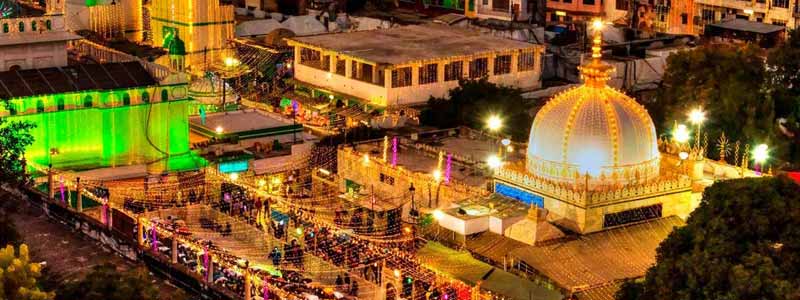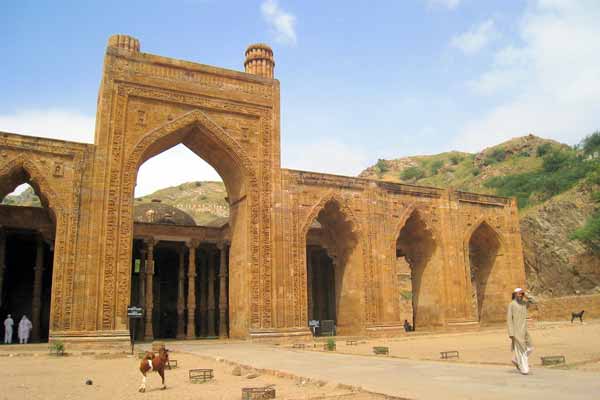Famous Monuments in Ajmer, a city in Rajasthan, India, boasts several famous monuments that showcase its rich historical and cultural heritage. The Ajmer Sharif Dargah is a prominent Sufi shrine dedicated to Moinuddin Chishti, drawing pilgrims of diverse backgrounds. The Taragarh Fort, dating back to the 7th century, stands atop a hill, providing breathtaking views of the city and the Aravalli Mountains.
Adhai Din Ka Jhonpra, a mosque with a unique blend of Hindu and Islamic architectural elements, is another notable site. Ana Sagar Lake, constructed in the 12th century, adds a scenic touch to the city with its gardens and pavilions. Mayo College, founded in 1875, is an esteemed boarding school known for its architectural blend of Rajput and British colonial styles.
These monuments encapsulate Ajmer‘s historical narrative, offering a glimpse into its spiritual, architectural, and educational dimensions. Whether attracting devout pilgrims or curious travelers, Ajmer’s landmarks contribute to the city’s vibrant tapestry of cultural and historical significance.

Ajmer Sharif Dargah
The Ajmer Sharif Dargah, also known simply as the Dargah Sharif or Ajmer Sharif, is one of the most revered Sufi shrines in India. It is located in Ajmer, Rajasthan, and is dedicated to the Sufi saint Khwaja Moinuddin Chishti. The Dargah is situated at the foot of the Taragarh Hill and is visited by millions of pilgrims and devotees every year, regardless of their religious beliefs.
Khwaja Moinuddin Chishti, popularly known as Gharib Nawaz (Benefactor of the Poor), was a 12th-century Sufi saint who played a significant role in spreading Sufism in the Indian subcontinent. He preached the message of love, peace, and brotherhood, and his teachings continue to inspire people from all walks of life Rajasthan Budget Tours.
The Dargah complex includes several structures such as the main shrine, courtyards, mosques, and other buildings. The iconic silver-plated doors of the Dargah, known as the Jannati Darwaza (Gate of Heaven), are adorned with intricate carvings and calligraphy.
One of the highlights of the Dargah is the Urs festival, held annually to commemorate the death anniversary of Khwaja Moinuddin Chishti. During this time, the Dargah becomes a hub of activity with devotees offering prayers, distributing sweets, and participating in qawwali performances.
The Ajmer Sharif Dargah holds immense spiritual significance for people of all faiths and is considered a symbol of religious harmony and unity in India. It continues to attract pilgrims and visitors who seek blessings, solace, and spiritual enlightenment.
Taragarh Fort
Taragarh Fort, also known as the Star Fort, is a historic fortification located in Ajmer, Rajasthan, India. It stands atop a steep hill and offers commanding views of the city and the surrounding Aravalli Range.
The fort was constructed in the 7th century by Ajaypal Chauhan, the founder of Ajmer, and later expanded and renovated by subsequent rulers. Its strategic location made it an important stronghold for various dynasties, including the Chauhans, Mughals, and Marathas, who controlled the region over the centuries.
Taragarh Fort is renowned for its impressive architecture, which includes massive stone walls, bastions, reservoirs, and intricately carved gateways. The fort’s design is primarily defensive in nature, featuring steep slopes and winding pathways to deter invaders.
One of the notable features of Taragarh Fort is its water reservoirs, which were built to ensure a continuous water supply to the fort during times of siege. The largest reservoir, known as the Bhim Burj, is capable of storing a significant amount of water.
Today, Taragarh Fort is a popular tourist attraction in Ajmer, offering visitors a glimpse into Rajasthan’s rich history and architectural heritage. Exploring the fort provides an opportunity to appreciate its historical significance and enjoy panoramic views of Ajmer and its surroundings.
Adhai Din Ka Jhonpra
Adhai Din Ka Jhonpra is a historical mosque located in Ajmer, Rajasthan, India. The name “Adhai Din Ka Jhonpra” translates to “two and a half days’ hut.” It is believed that the mosque was constructed in a remarkably short span of time, possibly two and a half days, hence the name.
The mosque was originally built as a Sanskrit college in the 12th century during the reign of Sultan Ghori. Later, it was converted into a mosque by Sultan Ghori when he conquered Ajmer. The mosque is known for its unique blend of Indo-Islamic architecture, showcasing intricate designs and calligraphy. The structure is supported by around 124 columns, many of which are ornately decorated with inscriptions and motifs.
The exterior facade of the mosque is adorned with arches, domes, and intricate carvings, displaying a fusion of Hindu and Islamic architectural styles. The structure is made primarily of red sandstone, adding to its architectural beauty.
Adhai Din Ka Jhonpra is not only a significant historical monument but also a prominent tourist attraction in Ajmer, drawing visitors with its architectural splendor and historical significance. It stands as a testament to the cultural exchange and syncretism that characterized medieval India.
Ana Sagar Lake
Ana Sagar Lake is a picturesque artificial lake located in Ajmer, Rajasthan, India. It was built in the 12th century by Anaji Chauhan, the grandfather of Prithviraj Chauhan, a famous Rajput king. The lake covers an area of approximately 13 kilometers and is bordered by beautiful marble pavilions, gardens, and parks.
The lake is a popular recreational spot for locals and tourists alike, offering opportunities for boating and leisurely walks along its well-maintained promenade. Visitors can also enjoy stunning views of the surrounding hills and the cityscape of Ajmer from the lake’s shores.
One of the prominent features of Ana Sagar Lake is the Daulat Bagh, a garden located on an island in the middle of the lake. This garden was built by Emperor Jahangir and is adorned with marble pavilions and fountains, adding to the charm of the lake.
Ana Sagar Lake holds historical significance as well, with several monuments and structures situated along its banks, including the Baradari, a pavilion built by Shah Jahan, and the Khobra Behroon temple dedicated to Lord Varuna, the Hindu god of water.
Overall, Ana Sagar Lake is not only a scenic attraction but also a place of historical and cultural importance in Ajmer, offering visitors a tranquil retreat amidst its serene surroundings.
Nasiyan (Red) Temple
The Nasiyan (Red) Temple, also known as the Lal Mandir, is a renowned Jain temple located in Ajmer, Rajasthan, India. It is famous for its stunning architecture and intricate craftsmanship, making it a significant religious and cultural landmark.
The temple is dedicated to Lord Rishabhdev, who is the first Tirthankara (spiritual teacher) of Jainism. It was constructed in the late 19th century by the Seth Moolchand Soni family, who were prominent jewelers and devout Jains.
One of the main attractions of the Nasiyan Temple is its unique feature known as the Swarna Nagari (City of Gold). This is a grand hall within the temple adorned with gold-plated wooden figures depicting various scenes from Jain mythology, including the life of Lord Rishabhdev.
The temple also houses a museum called the “Soni Ji Ki Nasiyan” which showcases a stunning display of intricate gold-plated wooden carvings, precious stones, paintings, and sculptures depicting the Jain philosophy and history.
Visitors to the Nasiyan Temple are not only captivated by its architectural beauty but also by the spiritual atmosphere that pervades the entire complex. The temple is a significant pilgrimage site for Jains and attracts tourists from all over the world who come to admire its exquisite craftsmanship and learn about Jainism’s rich cultural heritage.
Mayo College
Mayo College, located in Ajmer, Rajasthan, India, is one of the country’s oldest and most prestigious boarding schools. Founded in 1875 by Richard Bourke, the 6th Earl of Mayo, who was the Viceroy of India at the time, the school was established to provide the sons of Indian nobility with a high-quality education in line with British public school standards.
The campus of Mayo College is spread over approximately 175 acres and features stunning architecture that blends elements of Rajput and British colonial styles. The campus includes historic buildings, lush gardens, and well-maintained sports facilities.
Mayo College follows the Indian Certificate of Secondary Education (ICSE) curriculum and offers education from grades 4 to 12. The school focuses not only on academic excellence but also on the overall development of students through various extracurricular activities, sports, and leadership programs Famous Monuments in Ajmer.
Over the years, Mayo College has earned a reputation for producing distinguished alumni who have excelled in various fields, including politics, business, sports, and the arts. The school continues to uphold its legacy of providing a world-class education and shaping the leaders of tomorrow.
